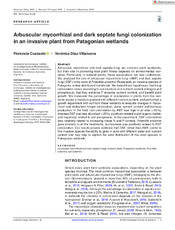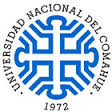JavaScript is disabled for your browser. Some features of this site may not work without it.
Mostrar el registro sencillo del ítem
| dc.creator | Cuassolo, Florencia | |
| dc.creator | Diaz-Villanueva, Verónica | |
| dc.date | 2023-09 | |
| dc.date.accessioned | 2023-10-10T13:29:24Z | |
| dc.date.available | 2023-10-10T13:29:24Z | |
| dc.identifier.issn | 1442-9993 | es_ES |
| dc.identifier.uri | http://rdi.uncoma.edu.ar/handle/uncomaid/17446 | |
| dc.description.abstract | Arbuscular mycorrhizal and dark septate fungi are common plant symbionts, but their role in promoting host plant fitness depends on environmental variables. Particularly in wetland plants, these associations are less understood. We analysed the role of arbuscular mycorrhizal fungi (AMF) and dark septate fungi (DSF) in the roots of Potentilla anserina (Rosaceae), an invasive species of Patagonia, widely distributed in wetlands. We tested three hypotheses: that fungi colonization varies according to soil moisture and nutrient content (nitrogen and phosphorus), that they enhance P. anserina nutrient content, and benefit plant growth. We measured the percentage of colonization in plants from five wetlands across a moisture gradient with different nutrient content, and performed a growth experiment with soil from these wetlands to evaluate changes in mycorrhizal and endophytic fungal colonization, aerial nutrient content and biomass production. In the field, root colonization by AMF was high in all sites (~90%), whereas DSF was less abundant (~20%), positively related to soil organic matter, and negatively related to soil phosphorus. In the experiment, DSF colonization was inversely related to increasing tissue N and P content. Potentilla anserina grew similarly in all the treatments, but biomass was positively related to DSF colonization. Our results provide evidence that DSF, rather than AMF, confer to this invasive species the ability to grow in soils with different water and nutrient content and may help to explain the wide distribution of this alien species in Patagonian wetlands. | es_ES |
| dc.format | application/pdf | es_ES |
| dc.format.extent | pp. 1-18 | es_ES |
| dc.language | eng | es_ES |
| dc.publisher | Ecological Society of Australia | es_ES |
| dc.relation.uri | DOI: 10.1111/aec.13438 | es_ES |
| dc.rights | Atribución-NoComercial-CompartirIgual 2.5 Argentina | es_ES |
| dc.rights.uri | https://creativecommons.org/licenses/by-nc-sa/2.5/ar/ | es_ES |
| dc.source | Austral Ecology. (2023) | es_ES |
| dc.subject | Arbuscular mycorrhizal | es_ES |
| dc.subject | Dark septate fungi | es_ES |
| dc.subject | Invasive plant | es_ES |
| dc.subject | Patagonian wetlands | es_ES |
| dc.subject | Potentilla anserina | es_ES |
| dc.subject | Soil nutrients | es_ES |
| dc.subject.other | Ciencias de la Tierra y Medio Ambiente | es_ES |
| dc.title | Arbuscular mycorrhizal and dark septate fungi colonization in an invasive plant from Patagonian wetlands | es_ES |
| dc.type | Articulo | es |
| dc.type | article | eu |
| dc.type | acceptedVersion | eu |
| dc.description.fil | Fil: Cuassolo, Florencia. Universidad Nacional del Comahue. Centro Regional Universitario Bariloche; Argentina. | es_ES |
| dc.description.fil | Fil: Cuassolo, Florencia. Instituto de Investigaciones en Biodiversidad y Medio Ambiente. Laboratorio de Limnología; Argentina. | es_ES |
| dc.description.fil | Fil: Cuassolo, Florencia. Consejo Nacional de Investigaciones Científicas y Técnicas; Argentina. | es_ES |
| dc.description.fil | Fil: Diaz-Villanueva, Verónica. Universidad Nacional del Comahue. Centro Regional Universitario Bariloche; Argentina. | es_ES |
| dc.description.fil | Fil: Diaz-Villanueva, Verónica. Instituto de Investigaciones en Biodiversidad y Medio Ambiente. Laboratorio de Limnología; Argentina. | es_ES |
| dc.description.fil | Fil: Diaz-Villanueva, Verónica. Consejo Nacional de Investigaciones Científicas y Técnicas; Argentina. | es_ES |
| dc.cole | Artículos | es_ES |



